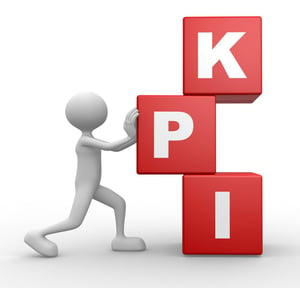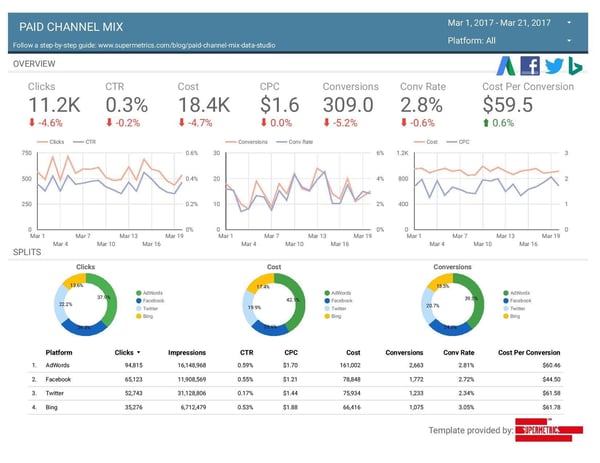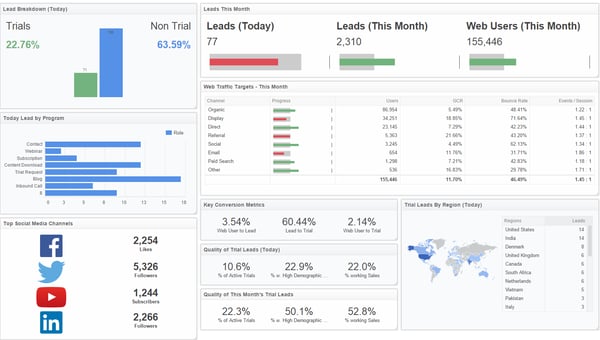 Key Performance Indicators or "KPIs" form an important part of the data that companies need to explain how they're progressing towards their marketing and business goals. However, many people today feel unsure about what a KPI might be in the marketing world.
Key Performance Indicators or "KPIs" form an important part of the data that companies need to explain how they're progressing towards their marketing and business goals. However, many people today feel unsure about what a KPI might be in the marketing world.
In basic terms, a key performance indicator is simply a measurable component that can be used to demonstrate the efficiency with which a company achieves their business objectives. Organizations use KPIs in their marketing campaigns to determine whether they're spending their budget in the right areas.
The Difference Between KPIs and Marketing Metrics

While the term "marketing metric" and "key performance indicator" are often used interchangeably, there's a small difference between the two. A crucial point to remember is that while all KPIs are marketing metrics, not all metrics are KPIs. Essentially, a "KPI" is one of the most important metrics a business must track when determining the success of their marketing campaigns. While these indicators don't need to be financial in nature, they should steer future marketing decisions.
Most key performance indicators will be:
- Actionable: Capable of being changed to improve business performance.
- Directional: Help to determine if a company's results are improving.
- Practical: Integrate with existing company processes well.
- Quantitative: Represented in the form of percentages or numbers.
Additionally, it's worth noting that key performance indicators must be based on legitimate data gathered during marketing campaigns. This data should be insightful and relevant to business objectives. In general, key performance indicators will often be linked to specific time frames, with checkpoints to address.
Examples of Key Performance Indicators in Marketing

The key performance indicators of an organisation aren't the same as it's goals. For instance, your technology company might have a goal to improve awareness of your brand in a specific geographic location. However, your key performance indicators might be things like website traffic, social media followers, and online engagement.
Some of the most common examples of KPIs for marketing include:
- Number of new customers acquired.
- Customer lifetime value.
- Cost per customer/acquisition.
- Return on Investment for ad-spend
- Customer attrition rates.
- Social media/brand awareness rates.
Regardless of the types of key performance indicator you choose for your company, each number should be important to your business because it allows you to focus on specific goals in your growth, and make sure that you're progressively moving towards your brand vision. KPIs can help companies to stay on track and choose marketing campaigns that are meaningful to their ultimate objectives.
How to Choose Your Marketing KPIs
Defining a distinct set of marketing KPIs for your company can be tricky. The most important word to focus on here is "key" because every KPI should be directly connected to a crucial business outcome. To help determine what your marketing KPIs should be, you can start by asking a few simple questions, such as:
- What are your end goals? What do you hope to achieve by improving these KPIs?
- Why does the outcome you've chosen matter to your brand?
- What will you need to do to measure progress towards your KPIs?
- How can you influence your business outcomes?
- How will you define whether you've reached your goal?
While it's worth paying attention to trends and industry standards, it's important to note that all companies don't need to use the same KPIs as their peers or marketplace competitors. Instead, the key performance indicators for your brand should be distinctly relevant to your specific marketing campaigns.
Defining "SMART" Key Performance Indicators
One of the top strategies for choosing key performance indicators includes using the "SMART" criteria for goal setting. This means that your indicators should be specific, measurable, attainable, relevant, and time-bound. Ask yourself whether your key performance indicators are as precise as possible, and how you're going to measure your progress with them.
Remember, while there's nothing wrong with being ambitious when choosing KPIs, you'll need to ensure that your goals are attainable and that they're relevant to your brand. Finally, make sure that you choose a time frame to keep you and your marketing team on track as you work towards success.
There's no specific rule or guideline suggesting that a brand should have a certain number of KPIs to track. Usually, most organisations will have anywhere between four and ten KPIs, but these can cover various points of the business, all the way from KPIs for marketing, to indicators for sales, customer experience, product development and more.


